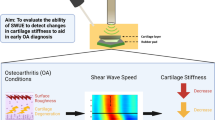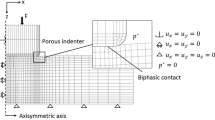Abstract
An ultrasound-compression system has been developed for the study of the layered biomechanical properties of articular cartilage. Cartilage specimens harvested from the bovine patella groove, with and without trypsin digestion, were tested using this system. It was noted that a large ultrasound reflection can be detected in the interface of the trypsin digestion front. This ultrasound reflection signal was used to differentiate the deformations of different portions of the cartilage throughout its depth when a load was applied. The equilibrium compression moduli of the digested, undigested and entire portions of articular cartilage were measured. The modulus of the cartilage without any digestion was 660±230kPa. After 1h digestion with 1 mg ml−1 trypsin solution, the thickness of the digested portion was 0.50±0.06 mm, and the modulus of the entire cartilage layer changed to 125±42 kPa. The moduli of the digested and undigested portions were 58±24 kPa and 470±31 kPa, respectively. Similar results were obtained for the cartilage with trypsin digestion for 2 h.
Similar content being viewed by others
References
Adam, C., Eckstein, F., Milz, S., andPutz, R. (1998): ‘The distribution of cartilage thickness within the joints of the lower limb of elderly individuals’,J. Anatomy,193, pp. 203–214
Adler, R. S., Dedrick, D. K., Laing, T. J., Chiang, E. H., Meyer, C. R., Bland, P. H., andRubin, J. M. (1992): ‘Quantitative assessment of cartilage surface roughness on osteoarthritis using high frequency ultrasound’,Ultrasound Med. Biol.,18, pp. 51–58
Agemura, D. H., O'Brien, W. D., Olerud, J. E., Chun, L. E., andEyre, D. E. (1990): ‘Ultrasonic propagation properties of articular cartilage at 100 MHz’,J. Acoustic Soc. Am.,87, pp. 1786–1791
Armstrong, C. G., andMow, V. C. (1982): ‘Variations in the intrinsic mechanical properties of human articular cartilage with age, degeneration, and water content’,J. Bone Joint Surg.,64-A, pp. 88–94
Athanasiou, K. A., Rosenwasser, M. P., Buckwalter, J. A., andMow, V. C. (1989): ‘Interspecies comparisons of in situ biomechanical properties of knee joint cartilage’,Trans. Orthop. Res. Soc.,14, p. 149
Bai, J., Fan, Y., Li, X., andLi, X., (1999): ‘Tracing echo segment selection method for strain reconstruction’,Ultrasonics,37, pp. 51–57
Berkenblit, S. I., Frank, E. H., Salant, E. P., andGrodzinsky, A. J. (1994): ‘Nondestructive detection of cartilage degeneration using electromechanical surface spectroscopy’,J. Biomech. Eng.,116, pp. 384–392
Brandt, K. D. (1974): ‘Enhanced extractability of articular cartilage proteoglycans in osteoarthrosis’,Biochem. J.,143, pp. 475–478
Buckwalter, J. A., andMankin, H. J. (1997): ‘Articular cartilage: Part II. Degeneration and osteoarthrosis, repair, regeneration, and transplantation’,J. Bone Joint Surg.,79-A, pp. 612–632
Cherin, E., Saied, A., Laugier, P., Netter, P., andBerger, G. (1998): ‘Evaluation of acoustical parameter sensitivity to agerelated and osteoarthritic changes in articular cartilage using 50 MHz ultrasound’,Ultrasound Med. Biol.,24, pp. 341–354
Cohn, N. A., Emelianov, S. Y., Lubinski, M. A., andO'Donnell, M. (1997a): ‘An elasticity microscope. Part I: Methods’,IEEE Trans. Ultrason. Ferroelect. Freq. Control,44, pp. 1304–1319
Cohn, N. A., Emelianov, S. Y., andO'Donnell, M. (1997b): ‘An elasticity microscope. Part II: Experimental results’,IEEE Trans. Ultrason. Ferroelectr. Freq. Control.,44, pp. 1320–1331
Ding, C. X., andBai, J. (1998): ‘Peak position estimation algorithms for cross-correlation function in elastography’, Proc. IEEE EMBS 20th Annual Conf., Hong Kong, pp. 866–868
Drogendijk, A. C., andMow, V.C. (1982): ‘Mapping of composition and biphasic material properties of cartilage over the patello-femoral groove’, Trans 25th Annual Meeting of ORS,4, p. 142
Fortin, M., Buschmann, M. D., Bertrand, M. J., Foster, F. S., andOphir, J. (2000): ‘Cross-correlation of ultrasound A-line to obtain dynamic displacement profiles within poroelastic materials undergoing stress-relaxation’. Proc. SPIE on Medical imaging 2000: Ultrasonic Imaging and Signal Processing,3982, pp. 286–294
Guilak, F., Ratcliffe, A., Lane, N., Rosenwasser, M. P., andMow, V. C. (1994): Mechanical and biochemical changes in the superficial zone of articular cartilage in canine experimental osteoarthritis’,J. Orthop. Res.,12, pp. 474–484
Jurvelin, J. S., Rasanen, T., Kolmonen, P., andLyyra, T. (1995): ‘Comparison of optical, needle probe and ultrasonic techniques for measurement of articular cartilage thickness’,J. Biomech.,28, pp. 231–235
Kallel, F., Ophir, J., Magee, K., andKrouskop, T. (1998): ‘Elastographic imaging of low-contrast elastic modulus distributions in tissue’,Ultrasound Med. Biol.,24, pp. 409–425
Kempson, G. E. (1980): ‘The mechanical properties of articular cartilage’ inSokoloff, L. (Ed.): “The joints and synovial fluid, vol. II’ (Academic Press, New York, 1980), pp. 177–238
Kim, H. K. W., Babyn, P. S., Harasiewicz, K. A., Gahunia, H. K., Pritzker, F. P. H. andFoster, F. S. (1995): ‘Imaging of immature articular cartilage using ultrasound backscatter microscopy at 50 MHz’,J. Orthop. Res.,13, pp. 963–970
Leung, C. T., Qin, L., Mak, A. F. T., Choy, W. T., andChan, K. M. (1998): ‘Correlation of imaging semi-quantification with biochemical assessment of proteoglycans content in trysinized articular cartilage,’ Proc. IEEE EMBS 20th Annual Conf., Hong Kong, pp. 2463–2466
Lyyra, T., Arokoski, J. P. A., Oksala, N., Vihko, A., Hyttinen, M., Jurvelin, J. S., andKiviranta, I. (1999): ‘Experimental validation of arthroscopic cartilage stiffness measurement using enzymatically degraded cartilage samples,’Phys. Med. Biol.,44, pp. 525–535
Mankin, H. J., Mow, V. C., Buckwalter, J. A., Iannotti, J. P., andRatcliffe, A. (1994): ‘Form and function of articular cartilage’ inSimnon, S. R. (Ed.): Orthopaedic basic science’ (American Academy of Orthopaedic Surgeons, 1994)
Mann, R. W., Shepherd, D. E. T. andSeedhom, B. B. (1999): “Discussion on: A technique for measuring the compressive modulus of articular cartilage under physiological loading rates with preliminary results’,Proc. Inst. Mech. Eng. H. J. Eng. Med.,213, pp. 291–292
Mann, R. W., Shepherd, D. E. T., andSeedhom, B. B. (2001): Discussion on: A technique for measuring the compressive modulus of articular cartilage under physiological loading rates with preliminary results’,Proc. Inst. Mech. Eng. H. J. Eng. Med.,215, pp. 123–124
Modest, V. E., Murphy, M. C., andMann, R. W. (1989): ‘Optical verification of a technique forin situ ultrasonic measurement of articular cartilage thickness’,J. Biomech.,22, pp. 171–176
Mow, V. C., andLai, W. M. (1980): ‘Recent developments in synovial joint biomechanics’,SIAM Review,22, pp. 275–317
Mow, V. C., Zhu, W., andRatcliffe, A. (1991): ‘Structure and function of articular cartilage and meniscus’ inMow, V. C., andHayes, W. C. (Eds). ‘Basic orthopaedic biomechanics’ (Raven Press, New York, 1991) pp. 143–198
Muir, I. H. M. (1980): ‘The chemistry of the ground substance of joint cartilage’ inSokoloff, L. (Ed.), ‘The joints and synovial fluid, vol. II’ (Academic Press, New York, 1980), pp. 27–94
Myers, S. L., Dines, K., Brandt, D. A., Brandt, K. D., andAlvrecht, M. E. (1995): ‘Experimental assessment by high frequency ultrasound of articular cartilage thickness and osteoarthritic changes,’J. Rheumatol.,22, pp. 109–116
Ophir, J., Cespedes, I., Ponnekanti, N., Yazdi, Y., andLi, X. (1991). ‘Elastography: a quantitative method for imaging the elasticity of biological tissues’,Ultrasonic Imag.,13, pp. 111–134
Roth, V., andMow, V. C. (1980): ‘The intrinsic tensile behavior of the matrix of bovine articular cartilage and its variation with age’,J. Bone Joint Surg.,62A, pp. 1102–1117
Rushfeldt, P. D., Mann, R. W. andHarris, W. H. (1981): ‘Improved techniques for measuring in vitro the geometry and pressure distribution in the human acetabulum. I. Ultrasonic measurement of acetabular surface, sphericity and cartilage thickness’,J. Biomech.,14, pp. 253–260
Saied, A. Cherin, E., Gaucher, H., Laugier, P., Gillet, P., Floouet, J., Netter, P., andBerger, G. (1997): ‘Assessment of articular cartilage and subchondral bone: subtle and progressive changes in experimental osteoarthritis using 50 MHz echographyin vitro’,J. Bone Mineral Res.,12, pp. 1378–1387
Schinagl, R. M., Ting, M. K., Price, J. H., andSah, R. L. (1996): Video microscopy to quantitate the inhomogeneous equilibrium strain within articular cartilage during confined compression’,Ann. Biomed. Eng.,24, pp. 500–512
Schinagl, R. M. Gurskis, D., Chen, A. C. andSah, R. L. (1997): ‘Depth-dependent confined compression modulus of full-thickness bovine articular cartilage’,J. Orthopaed. Res.,15, pp. 499–506
Senzig, D. A., Forster, F. K., andOlerud, J. E. (1992). ‘Ultrasonic attenuation in articular cartilage’,J. Acoustic Soc. Am.,92, pp. 676–681
Setton, L. A., Zhu, W., andMow, V. C. (1993): ‘The biphasic poroviscoelastic behavior of articular cartilage: Role of the surface zone in governing the compressive behavior’,J. Biomech.,26, pp. 581–592
Skovoroda, A. R., Lubinski, M. A., Emelianov, S. Y., andO'Donnell, M. (1999): ‘Reconstructive elasticity imaging for large deformations’,IEEE Trans. Ultrason. Ferroelectr. Freq. Control,46, pp. 523–535
Suh, J. K., Youn, I., Kyung, H. S., Petrie, R., andFu, F. H. (1999): “Determination of the mechanical properties of articular cartilage using a high frequency ultrasonic indentation technique’, ASME 1999 Bioengineering Conference,BED-42, pp. 65–66
Tepic, S., Macirowski, T., andMann, W. R. (1983): ‘Mechanical properties of articular cartilage elucidated by osmotic loading and ultrasound’. Proc. Natl. Acad. Sci. USA,Biophys.,80, pp. 3331–3333
Toyras, J., Rieppo, J., Nieminen, M. T., Helminen, H. J., andJurvelin, J. S. (1999): ‘Characterization of enzymatically induced degradation of articular cartilage using high frequency ultrasound’,Phys. Med. Biol.,44, pp. 2723–2733
Woo, S. L. Y., Akeson, W. H., andJemmot, G. F. (1976): ‘Measurements of nonhomogeneous, directional mechanical properties of articular cartilage in tension’,J. Biomech.,9, p. 785
Yao, J. Q., andSeedhom, B. B. (1999): ‘Ultrasonic measurement of the thickness of human articular cartilage in situ’,Rheumatology,38, pp. 1269–1271
Zheng, Y. P., andMak, A. F. T. (1996): ‘An ultrasound indentation system for biomechanical properties assessment of soft tissuesin vivo’,IEEE Trans. Biomed. Eng.,43, pp. 912–918
Zheng, Y.P., Mak, A.F.T., Qin, L., andDing, C. X. (1998): ‘Ultrasound elastography of articular cartilage: A preliminary study’. Proc. 20th Annual Int. Conf. of IEEE EMBS, Hong Kong, pp. 1940–1942
Zheng, Y. P., andMak, A. F. T. (1999): ‘Effective elastic properties for lower limb soft tissues from manual indentation experiment’,IEEE Trans. Rehab. Eng.,7, pp. 257–267
Zheng, Y. P., Mak, A. F. T., andLue, B. K. (1999): ‘Objective assessment of limb tissue elasticity: development of a manual indentation procedure’,J. Rehab. Res. Dev.,36, pp. 71–85
Author information
Authors and Affiliations
Corresponding author
Rights and permissions
About this article
Cite this article
Zheng, Y.P., Ding, C.X., Bai, J. et al. Measurement of the layered compressive properties of trypsintreated articular cartilage: An ultrasound investigation. Med. Biol. Eng. Comput. 39, 534–541 (2001). https://doi.org/10.1007/BF02345143
Received:
Accepted:
Issue Date:
DOI: https://doi.org/10.1007/BF02345143




